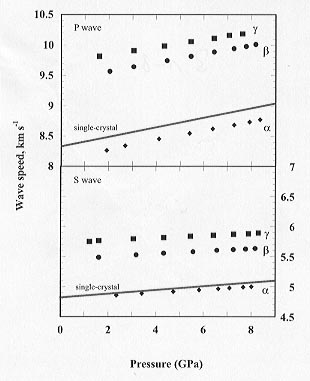

The polymorphic phases of (Fe,Mg)2SiO4 olivine, wadsleyite and ringwoodite, are considered to be major phases in the mantle. The phase transformations, from olivine to wadsleyite phase and from wadsleyite to ringwoodite phase, are believed to be related to the rapid, or discontinuous changes in seismic wave speed at 410 km and 520 km depth. The magnitude of the seismic discontinuities are often used to estimate the composition of the mantle by comparing the elastic properties of the three polymorphs determined in the laboratory with seismological observations. To date measurements of the elastic properties at high pressures and high temperatures of the three polymorphs have mainly concentrated on the Mg-end member compositions. In this study the effect of Fe content on the elasticity of the polymorphs has been investigated at high pressures.
A polycrystalline specimen of San Carlos olivine has been hot-pressed at 300 MPa, 1250° C in a gas-medium apparatus, and its high pressure polymorphs, wadsleyite and ringwoodite, were synthesized from San Carlos olivine at 13 and 19 GPa, 1000° C, respectively, in the multianvil press. The specimens were characterised by density measurements, X-ray diffraction and Raman spectroscopy. The elastic wave speeds of all three phases were determined both at ambient conditions, and at high pressures in the multianvil press, using a MHz ultrasonic interferometer.
The sound speeds for the high pressure phases measured at 1 atm in this study fall between the Reuss and Voigt bounds calculated from the available single-crystal stiffness coefficients within the uncertainties. Due to the large sample volume of olivine it was possible to examine the elastic anisotropy along different sample directions. This olivine sample has shown 3% difference in P wave speed between the cold-pressing (Y axis) and the confining (X axis) directions, but not for S waves. The P wave speeds measured at 1 atm are consistent with those extrapolated from the high-pressure data, which suggests that the anisotropy is not a result of microcracks in the specimen oriented perpendicular to the cold-pressing direction. It is more likely due to some weak crystallographic preferred orientation induced during cold pressing.
 |
Fig. 3.1-8: Elastic wave speeds (P and S waves) of olivine (  , solid diamonds), wadsleyite ( , solid diamonds), wadsleyite ( , solid circles) and ringwoodite ( , solid circles) and ringwoodite ( , solid squares) as a function of pressure. The grey solid lines are the elastic wave speeds calculated from the single-crystal data for San Carlos olivine. Although the absolute values of the elastic wave speeds of olivine are lower than those calculated from the single-crystal data, the pressure derivatives (the slopes) for single-crystal and polycrystalline specimens are the same. The pressure derivatives of the elastic wave speeds of the three polymorphs are very similar. , solid squares) as a function of pressure. The grey solid lines are the elastic wave speeds calculated from the single-crystal data for San Carlos olivine. Although the absolute values of the elastic wave speeds of olivine are lower than those calculated from the single-crystal data, the pressure derivatives (the slopes) for single-crystal and polycrystalline specimens are the same. The pressure derivatives of the elastic wave speeds of the three polymorphs are very similar.
|
From the high-pressure measurements, the pressure derivatives of elastic wave speeds of olivine measured along the low-speed direction are similar to those calculated from the single-crystal data (Fig. 3.1-8).  V(P,S)/
V(P,S)/ P for Fe-bearing high pressure phases (wadsleyite and ringwoodite) determined in this study are very similar. Within the mutual uncertainties, the pressure derivatives of the Fe-bearing wadsleyite and ringwoodite are the same as those of the Mg-end members.
P for Fe-bearing high pressure phases (wadsleyite and ringwoodite) determined in this study are very similar. Within the mutual uncertainties, the pressure derivatives of the Fe-bearing wadsleyite and ringwoodite are the same as those of the Mg-end members.
In summary, although the addition of Fe changes the elastic moduli of all three polymorphs at ambient conditions it has little effect on the pressure derivatives of the elastic wave speeds. Similarly, minor anisotropy has little effect on the pressure derivatives. Most importantly, the values of  V(P,S)/
V(P,S)/ P for all three phases are very similar, which means that the impedance contrasts (the product of density and velocity) among them at ambient conditions are a good guide to those at high P-T conditions, unless the temperature derivatives for these three phases are very different.
P for all three phases are very similar, which means that the impedance contrasts (the product of density and velocity) among them at ambient conditions are a good guide to those at high P-T conditions, unless the temperature derivatives for these three phases are very different.

Tel: +49-(0) 921 55 3700 / 3766, Fax: +49-(0) 921 55 3769, E-mail: bayerisches.geoinstitut(at)uni-bayreuth.de
 Previous page
Previous page